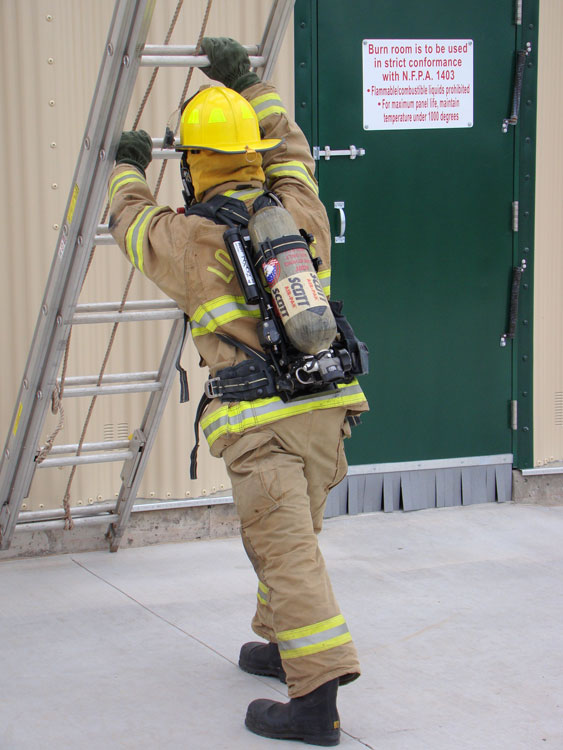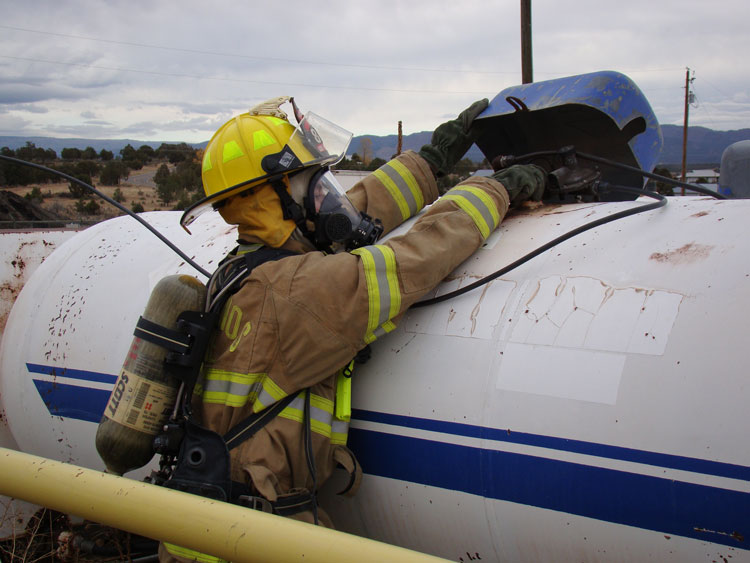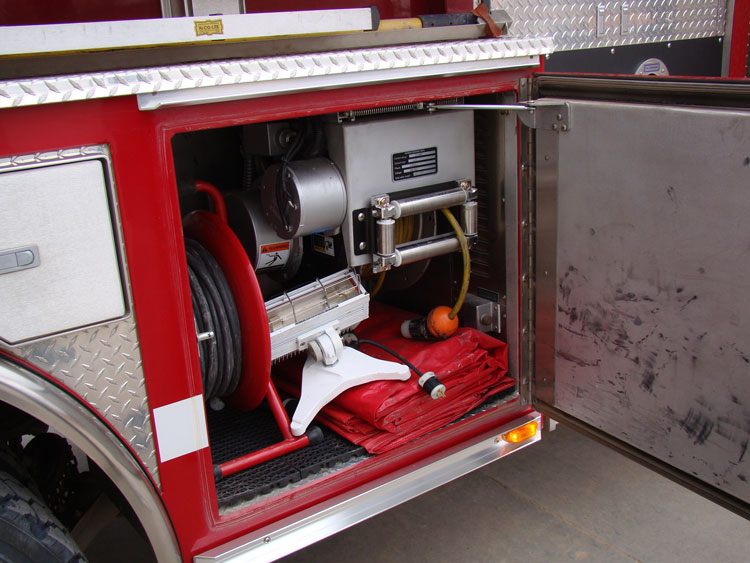
Article and photos by Thomas W. Aurnhammer
The following tactics should be considered as part of the overall fireground strategy enacted by the IC. In a rural environment, it becomes critical that these tactics are incorporated into the department’s training program so that all members have the proficiency to carry out the tasks. Not knowing who will be the “truck,” so to speak, will require all members to have the knowledge, skills, and abilities to carry out the duties on the fireground.
Search and Rescue
The priority of all firefighters arriving at an incident is, of course, rescue. A primary search, must be made, followed by a more thorough secondary search. Varying conditions will dictate when and how to conduct this operation. Depending on conditions and available staffing, limiting firefighting operations may be required to effect rescues, or attack lines may have to be deployed to protect escape routes. Additional objectives may also be incorporated into this operation in the way of forcible entry, checking for fire extension, and ventilation.
Forcible Entry
Forcible entry should not be limited to gaining access to the building. The initial attack team should have forcible entry support to open up other locked doors that firefighters may encounter in the building. This requires training in the most efficient methods of gaining entry and having the correct equipment available based on local needs. The “through-the-lock” method can be much more effective than sheer brute force. The methods used should match the challenges faced in your jurisdictions. In rural areas with no commercial development, the basic tools may be all that is needed for the task.

(2) Using the building to assist in raising ladders can ease some of the workload for short staffed departments.
Laddering
The proper placement of ground ladders early on at a structure fire can accomplish several objectives. The ladders can allow firefighters to gain access (to the roof or upper floors), rescue victims, provide escape routes, and advance hoselines. Depending on the personnel available on the fireground, there may be times that the “standard” ladder raises become impractical. In estimating the number of firefighters you typically gather at an incident, ladder training may have to be modified to practice raising ladders with fewer people. To maintain safety and ease some of the workload, the building should be used whenever possible to stabilize the ladder as it is raised.

(3) Even without a ladder truck, ventilation is an essential part of a coordinated interior fire attack.
Effective communications are required to coordinate the actions of the vent team with the attack team. Proper ventilation can reduce the probability of flashover or backdraft, increase visibility, and possibly enable an effective fire attack. Firefighters assigned to perform ventilation need a big picture-perspective as to what conditions may be created when opening up the structure. “We must possess enough information to be sure that the ventilation plan has a defined objective, facilitating our operations and/or victim survivability, and aids in the achievement of our overall mission – preserving life and property” (Papa, 2016, para. 4). A few factors should be considered here in choosing the proper ventilation tactic. Are you venting for fire attack or rescue? Should you go horizontal or vertical? What is the size and location of the fire? What effect will the building’s construction and the weather have on the operation? The different aspects that must be considered here stress the importance of training in all the various types of ventilation operations. That training should also stress firefighter safety, and not creating a larger fire problem.
The flow path that venting will create must be considered. Kerber (2013) describes flow path as the term defining the course of least resistance that heat and smoke will travel from a high-pressure area to a low-pressure area in the interior and on the exterior of a burning structure. “Operations conducted in the flow path can place firefighters at significant risk due to the increased flow of fire, heat, and smoke toward their position” (Kerber, 2013, p. 6). The concept of door control goes hand-in-hand with the impact of fire gases traveling along the flow path. Limiting the amount of air entering the fire building will slow the fire’s growth (Kerber, 2013). Door control is not the end-all to keep the fire from growing, and some method of limiting air entering the building should be maintained until water is on the fire.

(4) Controlling the utilities can range from simply shutting off the fuel supply on a LP gas tank to having to call for the electric company to assure the power to the building has been secured.
Controlling the Utilities
Firefighters should have a basic familiarity of utility systems before attempting to shut them down. Electricity can poise a severe threat to personnel and electric company workers should be requested to respond to all working structure fires. While firefighters may be able to accomplish some power shut-down by turning off main breakers and other disconnects, in many situations it may be advisable to wait for the electric company to arrive.
Because there are different gas shut-off procedures for different gas systems (natural or LP), you may want to contact your local gas providers for training and guidance. Once a system has been shut-down by firefighters, a qualified professional will need to be contacted to restore the system.
Water systems don’t present much of a hazard, but can cause additional damage if left unchecked. Firefighters should be able to locate the shut-off valve for the water line that enters the structure. If the valve cannot be completely shut off, or is rusted open, water company assistance may also be required.
Scene Lighting
Sometimes lighting the fireground becomes an afterthought when darkness begins to fall. At a minimum, Robertson (2010) points out we should light up the four sides of the building, the roof, and, at some point, the interior of the structure. Whether you accomplish that task with apparatus-mounted lights or portable lighting, the goal is to create safer operating conditions for firefighters at the scene.

(5) Salvage should not be performed as an afterthought, and assuring needed equipment (such as tarps and lights) is available on your apparatus will assist in performing the task.
Salvage and Overhaul
Once the fire has been controlled, concealed spaces will need to be opened up to check for hidden fire. Overhaul encompasses any operations needed to ensure that a rekindle cannot occur. Some firefighters may be hesitant to “open up” portions of a fire building, fearing they are causing more damage. The alternative to not carrying out this task can be much worse if the fire department is called back to extinguish the fire they missed the first time.
Salvage includes those actions which shield the building and its contents from preventable damage due to water or other elements, such as the weather. As soon as the fire is controlled and available personnel permit, salvage operations should begin. This would include the throwing of salvage covers, de-watering operations, removing items of value, and covering openings made for ventilation. The simplest actions taken to protect someone’s valuables can reduce some of the trauma that a fire victim goes through, and provides the department with a public relations benefit.
As a reminder, care must be taken in both operations to ensure that evidence needed to determine the origin and cause of the fire is not destroyed.
Although some rural fire departments may say “we don’t have a truck company,” the need for “truck company work” to be carried out should be evident. The secret here is for the IC to remember to make these assignments when the work needs to be done, and not as an afterthought. At times, we may think that since these tasks don’t directly relate to “putting the wet stuff on the red stuff,” that they aren’t that important. However, when trying to conduct a safe and effective fire attack, these duties are paramount in getting the job done.
Thomas W. Aurnhammer, a 42-year fire service veteran and fifth-generation firefighter, is currently the Chief of the Los Pinos Fire District in Ignacio, Colorado. He is a graduate of the NFA’s Executive Fire Officer (EFO) Program and holds a Bachelor Degree in Fire Administration. He is also a Chief Fire Officer (CFO) designee, as well as a Member in the Institution of Fire Engineers (MIFireE) – US Branch. He is also the co-host of the “Back Step Boys” radio program along with Ron Kanterman.
REFERENCES
Dodson, D. (2007). Fire Department Incident Safety Officer (2nd ed.). Clifton Park, NY: Delmar.
Insurance Services Office. (2013). Fire protection rating schedule. Jersey City, NJ: Verisk Analytics.
Kerber, S. (2013). Study of the effectiveness of fire service vertical ventilation and suppression tactics in single family homes. Northbrook, IL: Underwriters Laboratories.
National Fire Protection Association. (2016). NFPA 1901: Standard for Automotive Fire Apparatus. Quincy, MA: National Fire Protection Association.
Norwood, P.J. (2015). “Vertical Ventilation: Should It Still Be a Primary Tactical Assignment?” Retrieved from http://emberly.fireengineering.com/articles/2015/09/vertical-ventilation-should-it-still-be-a-primary-tactical-assignment.html
Papa, N. (2016). “The Four Tenets of Tactical Ventilation: Part One” – Informed. Retrieved from http://community.fireengineering.com/profiles/blog/show?id=1219672%3ABlogPost%3A627047
Reeder, F. (2014). “A Twist on Truck Operations.” Retrieved from http://www.firerescuemagazine.com/articles/print/volume-9/issue-4/training-0/a-twist-on-truck-operations.html
Robertson, H. (2010). “Tips for Effective Incident Scene Lighting.” Retrieved from http://www.firerescuemagazine.com/articles/print/volume-5/issue-11/training-0/tips-for-effective-incident-scene-lighting.html
RELATED
Dunn’s Dispatch: Rekindle Fires
Ventilation Limited Fire: Keeping it Rich and Other Tactics Based Off Science
Throw Back to Basics: Single-Firefighter Extension Ladder Raise
Rural Connections: Water Supply
Rural Connections: The Importance of Training

